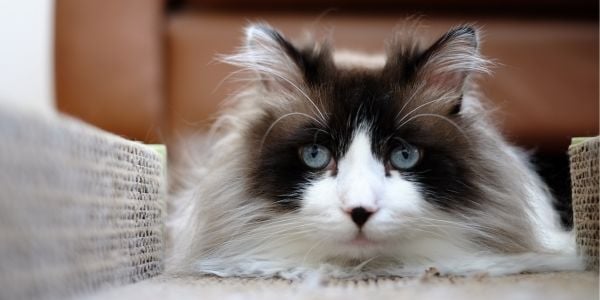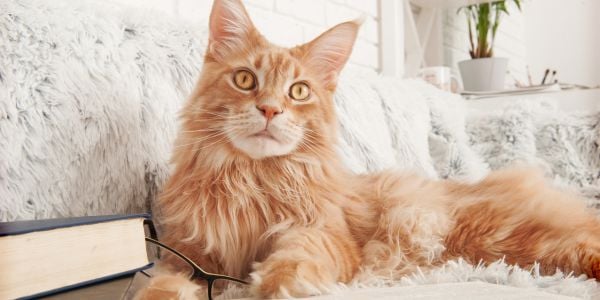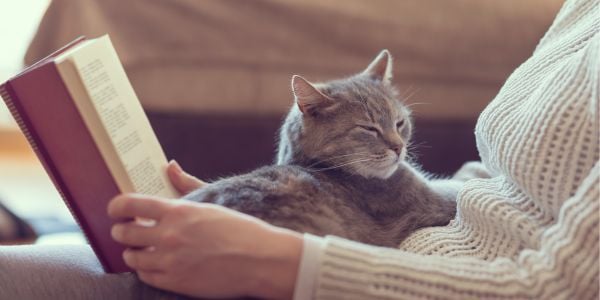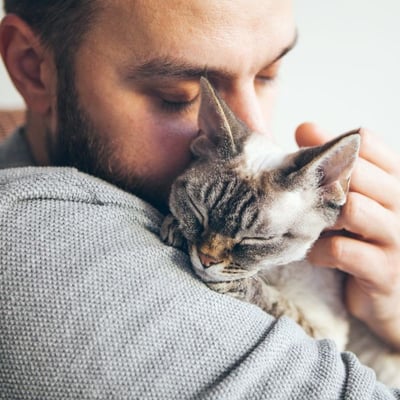 There are certain topics that pet owners don’t research unless they have a real need to.
There are certain topics that pet owners don’t research unless they have a real need to.
My guess is that you are only reading about aortic thromboembolism (ATE) because you suspect or already know your cat is suffering with it.
If this is the case, I am truly sorry, and I hope this article helps you learn about this condition and how you can help your cat live more comfortably.
NOTE: If your cat is suddenly vocalizing, appears distressed or painful, can’t walk, is rapid open-mouth breathing, and/or their toes are cool to the touch, seek veterinary care immediately. DO NOT DELAY. The outcome of delaying treatment (after 6 hours) for ATE is poor.
Skip to section
What Is Aortic Thromboembolism (ATE)?
Hearing that your cat has a condition called aortic thromboembolism (also referred to as saddle thrombus) is not only scary but overwhelming. Personally, once I start hearing big words for a diagnosis, my brain shuts down.
So, let’s begin by breaking down what aortic thromboembolism means to better understand what has happened.
Oxygenated blood is carried from the heart to the rest of the body via the main artery called the aorta.
When a blood clot occurs within a chamber of the heart or one of the blood vessels, it is referred to as a thrombus.
When that blood clot has moved via a blood vessel to a location distant from where it was originally formed, it is called an embolism.
Therefore, an aortic thromboembolism occurs when a blood clot formed in the left atrium or the aorta is displaced and moves to a location far from it via the aorta.
The blood clot becomes lodged into an area where the narrower diameter of the vessel prevents further movement of the clot.
Of cats with systemic thromboembolisms (clots that occur between the heart and the rest of the body), 90% will be lodged at the base of the aorta (the largest artery that brings blood away from the heart).
Other locations thromboembolisms can lodge include the brachial (supplies the forelimb), visceral (supplies the organs, and cerebral (supplies the brain) arteries.
The tissue that was receiving blood from that segment of the aorta (e.g., the hind limbs) now has a reduction in blood flow and decreased oxygen supply.

Cats at Risk for Aortic Thromboembolism
Age: Cats aged 8 to 12 years appear to be most affected, but it has been reported in cats as young as 1 and up to 16 years of age.
Heart Disease: The most common cause of this condition is heart disease, but it has also been associated with neoplasia and thyroid disease. In 12% to 25% of cats with hypertrophic cardiomyopathy (HCM) and 25% of unclassified cardiomyopathy (heart muscle disease), aortic thromboembolism was found.
Male Cats: There is a higher incidence of ATE among male cats than female cats. This is likely since male cats are more commonly affected than females by heart disease.
Breed: There are varying reports about breed predisposition to ATE. Since there is a higher prevalence of ATE in cats with HCM, those breeds predisposed to hypertrophic cardiomyopathy have a higher risk of developing ATE. Those breeds include:
- Maine Coon
- Ragdoll
- British Shorthair
- Sphynx
- Persian
- Chartreux
Pedigree breeds that are represented disproportionally or too largely in the selected population of cats in studies or surveys and may be at higher risk:
- Himalayan
- Siamese
- Birman

Symptoms of Feline Aortic Thromboembolism (ATE)
Typically, cats appear normal before the event occurs, and most owners are unaware of any prior issues.
The symptoms are typically sudden and severe in onset. They can vary with the location of the thromboembolism (limb arteries versus non-limb arteries – mesenteric, renal, and cerebral) and the degree of the blockage (partial or complete).
Clinical symptoms for ATE include:
- Distress
- Discomfort
- Vocalization
- Panting (to check your cat's respiratory rate, see the video later in this section)
- Hypothermia (low body temperature) – Normal temperature should be between 99 to 103 F. NOTE: Hypothermia may be the result of decreased body-wide perfusion of blood (blood flow) or secondary to shock.
Shock is caused by:
- An abnormality in the distribution of blood due to low blood pressure or vasodilation (dilated blood vessels, which lowers blood pressure) or
- Impaired heart function, which causes a decrease in the amount of blood pumped out of the ventricles (heart chamber) during contractions, congestion of veins, and vasoconstriction( blood vessels narrow), or
- A combination of both
- Most common location of an aortic thromboembolism affects the hind legs and results in:
- Severe pain in one or both hind limbs
- Paresis (weakness)
- Paralysis
- Limbs are cool to the touch compared to other limbs
- Paw pads appear to be pale, purple, or bluish in color
- Muscles are firm and painful
- Weak or absent femoral pulse (the pressure in the artery that goes up – as the blood is pushed through when the heart beats and then down when the heart relaxes – see below for how to check this on your cat)
- Variable heart rate – fast or slow
- Other symptoms can include:
- Vomiting
- Abdominal pain
- Central nervous system abnormalities (dragging affected limb, stumbling, disorientation, collapse)
Checking your cat's femoral or heart rate
A nomal rate for a cat's femoral pulse matches their heart rate. A cat's normal heart rate at rest is 160 to 200 beats per minute. You can see how to check it at 2:40 in this video. A dog is featured, but the same process is used for cats. You can see it taken on a cat here as well.
Checking your cat's respiratory rate
A cat's normal breathing rate is between 10 to 40 breaths per minute. This video explains how to count their breaths.
What Is the Treatment for ATE?
Diagnosing & Stabilizing Aortic Thromboembolism
Diagnosis of ATE, especially when the hindlimbs are affected and the five cardinal signs are present (pain, paresis/paralysis, lack of pulse, cold limbs, paleness), is based typically on physical exam findings alone. Further diagnostic testing isn't usually needed.
Since most cats show up at the hospital in severe pain and distress, prompt treatment with pain medication and oxygen therapy is essential.
Once these issues are addressed, your veterinarian will advise you on further treatment options based on various prognostic (outcome) factors. Factors associated with poor outcomes include:
- Temperature less than 98.6 degrees
- Decreased heart rate
- Lack of motor function (muscle movement)
- More than one limb affected
- Underlying congestive heart failure confirmed (done via ultrasound or thoracic x-rays as well as listening to the heart with a stethoscope)
Once your cat is stabilized with oxygen and pain medications, they will then need prompt treatment for shock and poor systemic perfusion.
However, an initial cardiac assessment looking for heart disease is essential since the treatments for shock and perfusion are influenced by whether your cat has heart disease.
Treatment of these conditions may involve intravenous fluid therapy, diuretics, and/or heart medications.
Antithrombotic Therapy
The next aspect of care involves your cat receiving antithrombotic therapy. The purpose of this therapy is to help prevent the spreading of existing blood clots and help prevent the formation of new blood clots.
Unfortunately, these medications do not cause the breakdown of existing blood clots. Initially, the treatment will be administered intravenously. Once your cat can handle oral medications, they will be transitioned to pills.
Your cat will be hospitalized for at least two days but likely longer. During which time, pain medications, as well as other medications, will be continued.
Physical therapy will also be an essential part of their care to avoid muscle contracture.
To evaluate for other underlying medical issues as well as to avoid complications, additional diagnostic testing is often necessary during their hospitalization.
At-Home Management
Your cat, if suffering from ATE, must be seen by a veterinarian. At-home care is only applicable after your cat has been treated by a veterinarian.
Following discharge from the hospital, your cat will require long-term management with antithrombotic therapy and medications to address heart disease and/or other medical conditions.
Your veterinarian will show you some passive range of motion exercises (PROM exercises similar to the ones in the video below) that need to be done for several weeks following discharge to help improve motor function and prevent muscle stiffening.
To help calm your cat before these exercises, ask your vet if it is ok to use calming treats and pheromones about 30 minutes prior to a PROM session so your cat is more relaxed and enjoys the session.
1. If you have help, you can use a Churu squeezable treat to keep your cat distracted and in place for this exercise.
2. If you're alone, you can use a suction cup toy to occupy your cat. This wand toy has longer rope attachments that can be used for when your cat is lying down.
Your cat will require life-long and frequent evaluations as well as diagnostic testing by their veterinarian to properly monitor and care for them.
Statistics About Aortic Thromboembolism in Cats
Some people, like me, need statistics to aid in the decision-making process when it comes to treatment and care.
When it comes to knowing what to do if your cat is diagnosed with ATE, I recommend following your heart and doing what you think is best for your cat.
Remember, cats never read stats; if they do, they try to prove them wrong by outdoing them.
-
The average hospital stay is 2 days.
-
Treated cats have a 50% survival rate.
-
When only one limb is affected, survival rates of as high as 70% to 80% are possible.
-
If motor function remains, the survival rate can be as high as 90%.
-
Those with hind limb dysfunction can show improvement as early as 4 days following the event, but some may take a couple of weeks to months.
-
When given aspirin for the prevention of clots, the average survival time was 192 days. Never give aspirin without guidance from a veterinarian, even if your cat has been diagnosed with heart disease.
-
For those receiving aspirin post-discharge from the hospital, approximately 6 to 12 months later, they had at least one more incidence of ATE.
-
Cats treated post-discharge with Plavix (Clopidogrel) had an average survival of 443 days.
-
Because of the risk of reoccurrence, the need for long-term treatments to avoid it happening again, the diagnosis of heart disease, as well as the fear of the cat’s suffering if the event occurs again, about 50% to 75% of cats are compassionately euthanized without treatment.
Can ATE Be Prevented?
Unfortunately, there are no published studies in veterinary literature that have evaluated treatments for ATE prevention.
What can be recommended is the following:
- Cats should be maintained at their ideal body weight.
- At-risk cats and any cat coming within the average age range for ATE should have frequent physical examinations and routine screening (blood work, thoracic x-rays, and/or echocardiogram).
- Any asymptomatic cat that is diagnosed with a murmur, gallop rhythm, or arrhythmia should have a complete cardiac workup.
- Plavix (Clopidogrel) therapy should be considered for the prevention of ATE for at-risk cats.
If you have an at-risk or a senior cat, I hope they never suffer with this devastating condition.
If you are already on this journey, my thoughts are with you and your cat. If you have any questions, ask them below.




